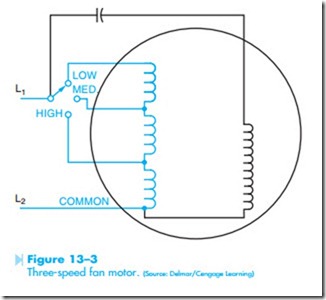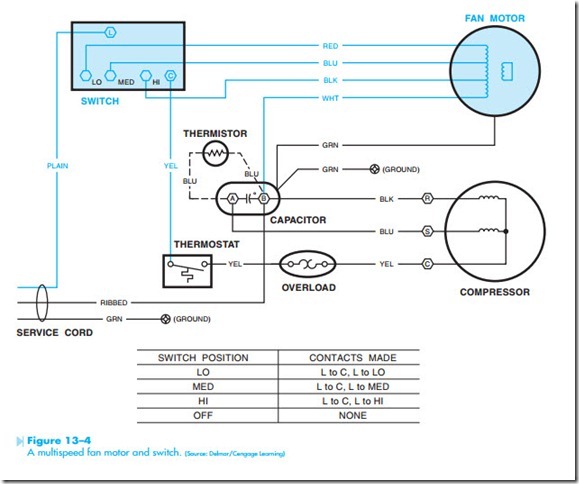Multispeed Motors
Multispeed AC motors have been used to a great extent in the air conditioning field for many years. There are two basic types of multispeed motors used. One type is known as the consequent pole motor. The other type is generally a permanent-split capacitor motor.
THE CONSEQUENT POLE MOTOR
The speed of the rotating magnetic field of an AC induction motor can be changed in either of two ways. These are:
1. Change the frequency of the AC voltage.
2. Change the number of stator poles.
The consequent pole motor changes the motor speed by changing the number of its stator poles. The run winding in Figure 13–1 has been tapped
in the center. If the AC line is connected to each end of the winding as shown, current flows through the winding in only one direction. Therefore, only one magnetic polarity is produced in the winding. If the winding is connected as shown in Figure 13–2, current flows in opposite directions in each half of the winding. Because current flows through each
Multispeed fan motors have been used in the air conditioning industry for many years. These motors are generally wound for two to five steps of speed, and are used to operate fans and squirrel-cage blowers. A schematic drawing of a three-speed motor is shown in Figure 13–3. Notice that the run winding has been tapped to produce low, medium, and high speed. The start winding is connected in parallel with the run winding section. The other end of the start lead is connected to an external oil-filled run capacitor. This motor obtains a change in speed by inserting inductance in series with the run winding. The actual run winding for this motor is between the terminals marked High and C. The windings shown between High and Medium are connected in series with the main run winding. When the rotary switch is connected to the medium-speed position, the inductive reactance of this coil limits the amount
of current flow through the run winding. When the current of the run winding is reduced, the strength of the magnetic field of the run winding is reduced and the motor produces less torque. This causes the motor speed to decrease.
If the rotary switch is changed to the low position, more inductance is connected in series with the run winding. This causes less current to flow through the winding and another reduction in torque. When the torque is reduced, the motor speed decreases again.
Common speeds for a four-pole motor of this type are 1,625, 1,500, and 1,350 RPM. Notice that this motor does not have the wide range between speeds as the consequent pole motor does. Most induction motors would overheat and damage the motor windings if the speed were to be reduced to this extent. This motor, however, has much higher impedance in its windings than most motors. The run windings of most split-phase motors has a wire resistance of 1 to 4 ohms. This motor will generally have a resistance of 10 to 15 ohms in its run winding. It is the high impedance of the windings that permits the motor to be operated in this manner without damage.
Because this motor is designed to slow down when load is added, it is not used to operate high- torque loads. This type of motor is generally used to operate only low-torque loads, such as fans and blowers. The schematic in Figure 13–4 shows a multispeed fan motor and switch.


